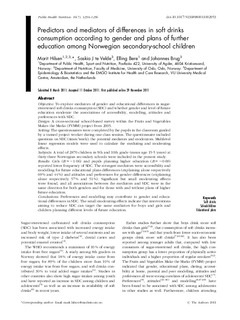| dc.contributor.author | Hilsen, Marit | |
| dc.contributor.author | te Velde, Saskia J. | |
| dc.contributor.author | Bere, Elling | |
| dc.contributor.author | Brug, Johannes | |
| dc.date.accessioned | 2013-07-19T13:22:49Z | |
| dc.date.available | 2013-07-19T13:22:49Z | |
| dc.date.issued | 2011 | |
| dc.identifier.citation | Hilsen, M., te Velde, S. J., Bere, E. & Brug, J. (2011). Predictors and mediators of differences in soft drinks consumption according to gender and plans of further education among Norwegian secondary-school children. Public Health Nutrition, 16(7), 1250-1256. | no_NO |
| dc.identifier.issn | 1475-2727 | |
| dc.identifier.uri | http://hdl.handle.net/11250/139072 | |
| dc.description.abstract | Objective: To explore mediators of gender and educational differences in sugar-sweetened soft drinks consumption (SDC) and whether gender and level of future education moderate the associations of accessibility, modelling, attitudes and preferences with SDC.
Design: A cross-sectional school-based survey within the Fruits and Vegetables Makes the Marks (FVMM) project from 2005.
Setting: The questionnaires were completed by the pupils in the classroom guided by a trained project worker during one class session. The questionnaire included questions on SDC (times/week), the potential mediators and moderators. Multilevel linear regression models were used to calculate the mediating and moderating effects.
Subjects: A total of 2870 children in 9th and 10th grade (mean age 15.5 years) at thirty-three Norwegian secondary schools were included in the present study.
Results: Girls (B=-1.06) and pupils planning higher education (B=-0.69) reported lower frequency of SDC. The strongest mediators were accessibility and modelling for future educational plans differences (explaining alone respectively 69% and 44 %) and attitudes and preferences for gender differences (explaining alone respectively 57% and 51 %). Significant but small moderating effects were found, and all associations between the mediators and SDC were in the same direction for both genders and for those with and without plans of higher future education.
Conclusions: Preferences and modelling may contribute to gender and educational differences in SDC. The small moderating effects indicate that interventions aiming to reduce SDC can target the same mediators for boys and girls and children planning different levels of future education. | no_NO |
| dc.language.iso | eng | no_NO |
| dc.publisher | Cambridge University Press | no_NO |
| dc.title | Predictors and mediators of differences in soft drinks consumption according to gender and plans of further education among Norwegian secondary-school children | no_NO |
| dc.type | Journal article | no_NO |
| dc.type | Peer reviewed | no_NO |
| dc.rights.holder | © 2011 The Author(s) | |
| dc.subject.nsi | VDP::Medical disciplines: 700::Health sciences: 800::Nutrition: 811 | no_NO |
| dc.source.pagenumber | 1250-1256 | no_NO |
| dc.source.volume | 16 | no_NO |
| dc.source.journal | Public Health Nutrition | |
| dc.source.issue | 7 | no_NO |
| dc.identifier.doi | https://doi.org/10.1017/S1368980011002953 | |
